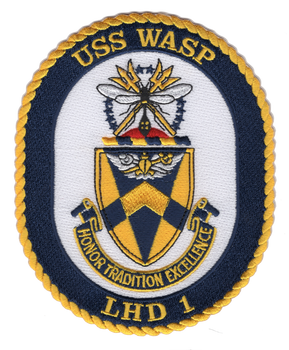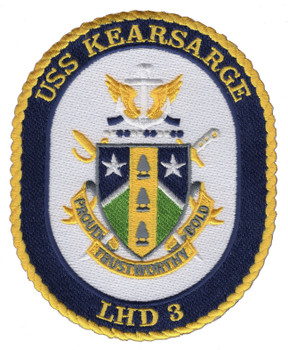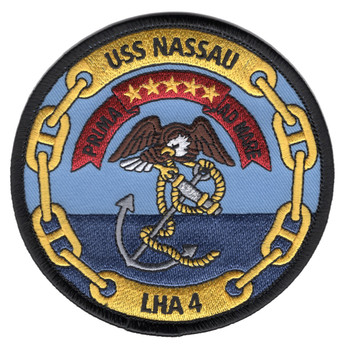Description
USS Monticello LSD-35 Amphibious Ship Patch (U.S. Navy) 4.5" x 4.5" Embroidered Patch with Sew-On Backing
Superior Materials: Made with premium polyester thread and durable twill fabric, ensuring long-lasting color and strength.
Advanced Embroidery Technology: Crafted using the most advanced embroidery machinery, guaranteeing intricate detail, sharp lines, and consistent quality every time.
Easy Iron-On Application: Features a heat-activated adhesive backing for quick, no-sew attachment. Simply position, iron, and press for a secure bond.
Versatile Use: Perfect for personalizing jackets, backpacks, uniforms, or any fabric surface that needs a touch of personality.
Durable and Washable: Designed to withstand everyday wear and occasional washing without fading or fraying.
Formations & Origins
USS Monticello (LSD-35) was a Thomaston-class dock landing ship commissioned into the United States Navy on March 29, 1957. Built by the New York Naval Shipyard in Brooklyn, she was the second ship to carry the name Monticello, honoring the Virginia estate of Thomas Jefferson. The ship was part of a class designed during the Cold War to improve upon the capabilities of earlier World War II-era LSDs, giving the Navy greater flexibility in amphibious warfare and power projection across the globe. Her construction reflected the Navy’s increasing focus on mobility, versatility, and support for the Marine Corps’ expeditionary mission.
Notable Commanders
Throughout her service, USS Monticello was commanded by a series of skilled naval officers who specialized in amphibious operations. These commanding officers oversaw numerous deployments and exercises that integrated the ship into large joint-force operations with the Marine Corps and allied navies. The ship’s captains were tasked with maintaining readiness under both peacetime training and combat conditions, often operating in volatile regions and under tight logistical timelines.
Major Campaigns/Operations
Monticello’s most active period came during the Vietnam War, where she deployed multiple times to Southeast Asia. She played a key role in amphibious operations along the Vietnamese coastline, acting as a staging and support platform for landing craft and Marine units. She took part in Operation Starlite and served in Amphibious Ready Groups that supported combat landings and logistical operations throughout the conflict.
Later, in 1975, she participated in Operation Frequent Wind, the emergency evacuation of Saigon at the end of the Vietnam War. Her capacity to support helicopters, small craft, and thousands of evacuees made her a valuable asset in this chaotic and historic mission. Outside of combat, Monticello was heavily involved in joint exercises across the Pacific, Indian Ocean, and Mediterranean, maintaining a constant presence during the Cold War.
Specialized Role/Equipment
Monticello’s defining feature was her large well deck, capable of flooding to launch and recover landing craft such as LCUs and LCMs. This allowed her to embark and deploy a wide array of amphibious vehicles and equipment directly to hostile shores. She also had the capability to support helicopters and transport Marine units with their gear, creating a full-spectrum amphibious assault platform. In addition to combat roles, Monticello was equipped with onboard repair facilities, medical treatment areas, and command spaces that allowed her to serve as a mobile hub for sustained operations.
Acts of Heroism
While not always in direct combat, the crew of USS Monticello displayed courage and discipline in the face of danger during numerous Vietnam-era amphibious assaults. Working in close proximity to enemy shores, sailors operated under the threat of mortar fire, mines, and air attacks while executing critical offloading and recovery operations. During Operation Frequent Wind, Monticello’s crew worked tirelessly to assist in the safe evacuation of civilians and personnel, maintaining composure amid the chaos and uncertainty of the fall of Saigon. Their efforts ensured the success of one of the largest non-combatant evacuations in U.S. Navy history.
Legacy & Notable Achievements
USS Monticello served for nearly three decades before being decommissioned on October 1, 1985. She embodied the Navy’s doctrine of amphibious warfare throughout the Cold War and left a lasting legacy in the evolution of joint Navy-Marine Corps operations. Her contributions in Vietnam and beyond demonstrated the essential role of amphibious dock landing ships in both combat and humanitarian missions. The ship's patch, often marked by imagery reflecting amphibious strength and mobility, remains a tribute to her role in projecting American presence and power wherever duty called.







